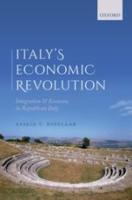
OUP (2019) h/b 297pp £70 (ISBN 9780198829447)
R. describes herself as an independent scholar based in the Netherlands but has taught and researched regularly at universities in the UK and the Netherlands. Her main area of study has been the later Roman Republic on which she has published widely. This is her second publication with the OUP—the first being Public Land in the Roman Republic in 2010.
This book pulls together many of the themes that she has covered in her earlier articles and although it prioritizes economics in its title (fairly enough given that the economic material may be newer to most readers), it is in practice an analysis of the development of Rome’s relationship with the rest of Italy from about 400 BC to the end of the Republic—economic, constitutional, legal, political and social.
R.’s academic hinterland contains some strongly held older mantras—for example, that the ancient world had no truck with modern capitalist theory and that the Romans engaged in an aggressive policy of Romanisation within Italy with a negative effect both socially and economically. She is resolute in politely questioning their validity.
In the absence of anything which could today be described as statistics, she bases her conclusions very heavily on epigraphy—drawn more from the communities south of Rome than to the north, although there appears to be no significant analytical difference to be drawn between the two areas. With the epigraphy comes the need to understand and interpret local languages, especially Oscan and Messapian, and the provenance of names. Archaeology contributes numismatic evidence and also signs of urban and commercial development on relevant sites. There is also some textual evidence, almost entirely from Roman sources, and R. is careful not to attribute infallibility to the detail in such sources. Her mastery of this material is indubitable.
Working with this material R. establishes, by examining developments thematically, that, far from being cowed, the Italian communities under Rome’s control broadly flourished economically and socially during this period; they arguably absorbed more cultural influences from the Greeks than from the Romans and may have contributed to a similar movement in Rome. They even developed a separate cultural identity as Italici—which is only one example of a steady organic drift towards integration (rather than conscious Romanisation). The communities were allowed much independence in local government, language and trade, although the Romans had no hesitation in intervening aggressively if they felt that their potestas was being challenged. Individual Roman officials also occasionally committed acts of oppression and brutality which were likely to go unpunished. There is no evidence that the constitutional status of a community—Roman colony, Latin colony or ally—automatically determined its prestige or wellbeing.
Why then did the Social War erupt in 91 BC when a number of communities (but by no means all) rebelled against Rome with some success? R. suggests that this arose not out of any desire for independence as such but because the communities felt that in several important respects (legal, commercial and financial) they were being unfairly discriminated against. The Romans quelled that revolt by granting over time Roman citizenship to all Italian communities. This worked, not because the Italians particularly wanted to become politically active in Rome but because the ancillary benefits of citizenship (notably access to legal remedies) eliminated most of the sources of the irritating discrimination.
Such a summary does little justice to the wealth of information provided in this book. It is, probably inevitably, a pretty dense read and the thematic treatment requires an element of repetition. The overall style is however gratifyingly lucid. There are three useful maps and 26 pages of bibliography. This book is probably not for the general reader but is undoubtedly essential reading for anyone studying the early development of the Roman Empire.
Roger Barnes
